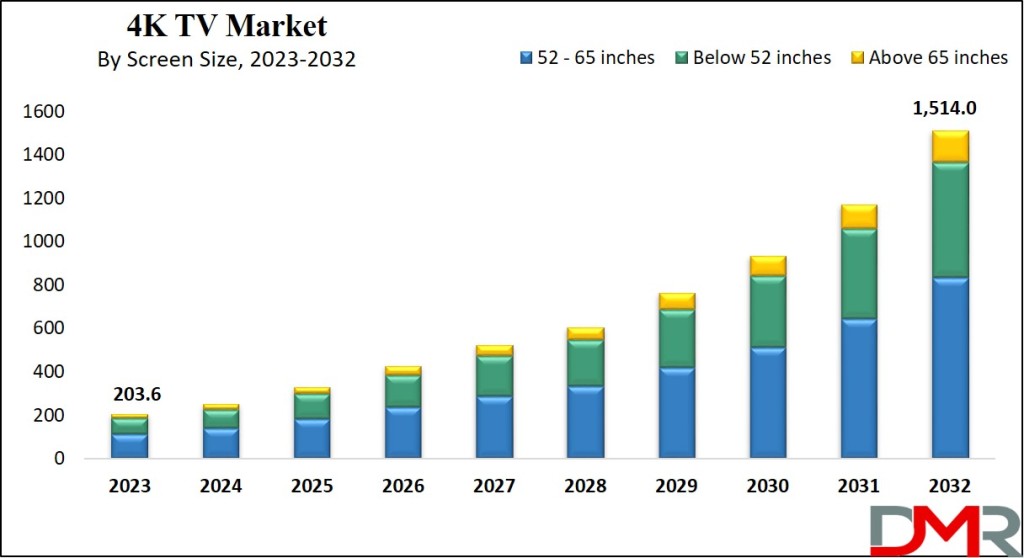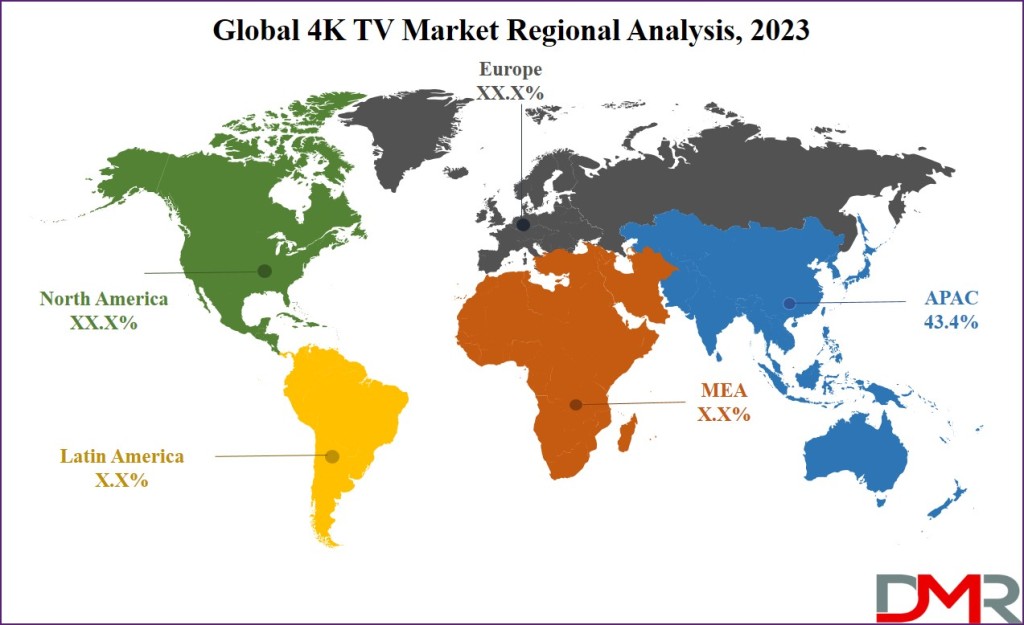4K TV Market: Unraveling the Landscape
Market Dynamics
The surge in demand for 4K TVs stems from consumers' increasing penchant for superior visual experiences. The remarkable clarity and resolution offered by 4K TVs have captivated consumers, particularly for larger screens, fostering a relentless pursuit of immersive viewing experiences. Moreover, advancements in manufacturing processes and economies of scale have propelled a significant reduction in prices, making 4K TVs more accessible to a broader consumer base. However, the initial higher purchase costs relative to standard Full HD TVs present a hurdle to widespread adoption. Despite the allure of 4K technology, the lack of a vast library of 4K content remains a substantial challenge, potentially dampening consumer enthusiasm.
The Global 4K TV Market is expected to reach a value of USD 203.6 billion in 2023, and it is further anticipated to reach a market value of USD 1,514.0 billion by 2032 at a CAGR of 25.0%. The market has seen a significant increase in the recent past and is predicted to grow significantly during the forecasted period as well.

Get a Totally Free PDF Sample Here@ https://dimensionmarketresearch.com/report/4k-tv-market/request-sample/
Key Takeaways
- The 4K TV market is driven by technological advancements, affordability, and increasing consumer demand for superior visual experiences.
- The residential sector leads market growth, fueled by home entertainment trends and technological enhancements.
- Asia Pacific commands a significant market share, while North America and Europe exhibit moderate growth trajectories.
- Industry giants like Samsung and LG Electronics are at the forefront of innovation, leveraging diverse product offerings to maintain market dominance.
- Continuous advancements in display technology, regulatory initiatives, and global economic trends shape the 4K TV market landscape.
- Targeted audiences include home entertainment enthusiasts, tech enthusiasts, gamers, commercial establishments, educators, advertising agencies, and government institutions.
- Recent developments, such as Samsung's Crystal Vision 4K TV series, underscore the industry's commitment to meeting evolving consumer needs.
Key Factors Driving the 4K TV Market
- Technological Advancements: Continuous innovations in display technology, including Quantum Dot LEDs and High Dynamic Range (HDR), are driving the adoption of 4K TVs.
- Affordability: Reduction in manufacturing costs and economies of scale have made 4K TVs more accessible to a broader consumer base.
- Increasing Demand for Superior Visual Experiences: Consumers' desire for sharper visuals and vibrant colors is propelling the growth of the 4K TV market.
- Availability of Content: The availability of a diverse range of 4K content from streaming services is stimulating consumer interest in upgrading to 4K TVs.
- Home Entertainment Trends: Remote work trends and social restrictions have heightened the demand for premium home entertainment experiences, driving adoption.
- Technological Enhancements: Features such as voice control, smart home integration, and compatibility with gaming consoles are enhancing the appeal of 4K TVs.
- Global Economic Trends: Rising disposable incomes, particularly in emerging markets, are contributing to the growth of the 4K TV market.
- Regulatory Environment: Favorable regulatory policies and initiatives aimed at promoting digitalization are fostering market growth.
Targeted Audience for 4K TVs
- Home Entertainment Enthusiasts: Individuals seeking immersive viewing experiences and superior image quality for home entertainment purposes.
- Tech Enthusiasts: Early adopters and technology enthusiasts interested in the latest advancements in display technology.
- Gamers: Gaming enthusiasts attracted to 4K TVs for their enhanced graphics, quick refresh rates, and compatibility with gaming consoles.
- Entertainment Industry Professionals: Professionals in the entertainment industry seeking high-quality displays for content creation and production.
- Commercial Establishments: Businesses, hotels, and public venues looking to enhance their customer experience with high-definition displays.
- Educators: Educational institutions seeking advanced display solutions for interactive learning experiences.
- Advertising Agencies: Agencies and marketers leveraging 4K TVs for high-impact advertising campaigns.
- Government Institutions: Government organizations employing 4K TVs for digital signage, surveillance, and communication purposes.
Buy this premium report here@ https://dimensionmarketresearch.com/checkout/4k-tv-market/
Regional Analysis
Asia Pacific: The Epicenter of Growth
Asia Pacific commands a significant share of the global 4K TV market, driven by the widespread availability of affordable 4K TVs. The region's robust demand underscores the immense potential for market expansion, buoyed by rising disposable incomes and technological advancements.

North America: Early Adopters Paving the Way
North America, characterized by its early adoption of 4K TVs, continues to witness substantial growth. Factors such as the proliferation of 4K set-top boxes and declining prices are poised to accelerate market penetration, with a significant portion of the population expected to embrace 4K technology.
Europe: Moderate Growth Trajectory
Europe's 4K TV market experiences moderate growth, propelled by increasing demand in countries like the UK and Germany. The integration of High Dynamic Range (HDR) technology is anticipated to drive growth in developed markets, further augmenting the region's market potential.
Research Scope and Analysis
By Screen Size
Dominance of 52 to 65 Inches
Televisions within the 52 to 65-inch range dominate the 4K TV market, capturing a significant portion of total revenue. The segment's growth trajectory is further propelled by rapid technological advancements, such as Quantum Dot LEDs (QLEDs), driving innovation and consumer interest. Manufacturers are actively investing in research and development to enhance graphic engines, delivering unparalleled viewing experiences.
By End User
Residential Sector Spearheading Growth
The residential sector emerges as the primary driver of 4K TV market growth, fueled by the increasing consumer demand for high-end home entertainment experiences. Factors such as remote work trends and social restrictions have propelled investments in premium viewing experiences, making 4K TVs an attractive proposition. Technological enhancements, including voice control and smart home integration, coupled with the availability of a diverse range of 4K content, have further bolstered adoption rates among residential users.
Competitive Landscape
The global 4K TV market is fiercely competitive, with industry behemoths such as Samsung, LG Electronics, and Sharp Corporation vying for market supremacy. These key players leverage their brand equity and diverse product offerings to entice consumers and maintain a competitive edge. For instance, Samsung's introduction of the Crystal Vision 4K TV series underscores the relentless pursuit of innovation to cater to evolving consumer preferences.
Frequently Asked Questions (FAQs)
1. What is the projected market value of the global 4K TV market?
- The Global 4K TV Market is expected to reach a value of USD 203.6 billion in 2023, with further growth anticipated to reach USD 1,514.0 billion by 2032 at a CAGR of 25.0%.
2. What factors are driving the growth of the 4K TV market?
- The growth of the 4K TV market is primarily driven by increasing demand for superior image quality, advancements in manufacturing processes, and declining prices, making 4K TVs more accessible to a wider consumer base.
3. What challenges does the adoption of 4K TVs face?
- Despite the allure of 4K technology, the initial higher purchase costs relative to standard Full HD TVs and the lack of a vast library of 4K content present significant adoption challenges.
4. Which end-user segment leads the 4K TV market?
- The residential sector spearheads market growth, fueled by increasing consumer demand for immersive home entertainment experiences and technological advancements.
5. Which regions exhibit significant growth in the 4K TV market?
- Asia Pacific commands a substantial share of the global 4K TV market, driven by widespread availability and affordability. North America and Europe also experience significant growth, albeit at a moderate pace.
6. Who are the key players in the global 4K TV market?
- Key players in the global 4K TV market include Samsung, LG Electronics, Sharp Corporation, Sony, Toshiba, and Panasonic, among others.
Conclusion
The 4K TV market continues to chart a trajectory of robust growth, underpinned by relentless technological innovation and increasing consumer demand for immersive viewing experiences. As industry players vie for market supremacy, the landscape remains dynamic, with opportunities abound for those adept at navigating the evolving consumer preferences and market dynamics.











Comments (0)